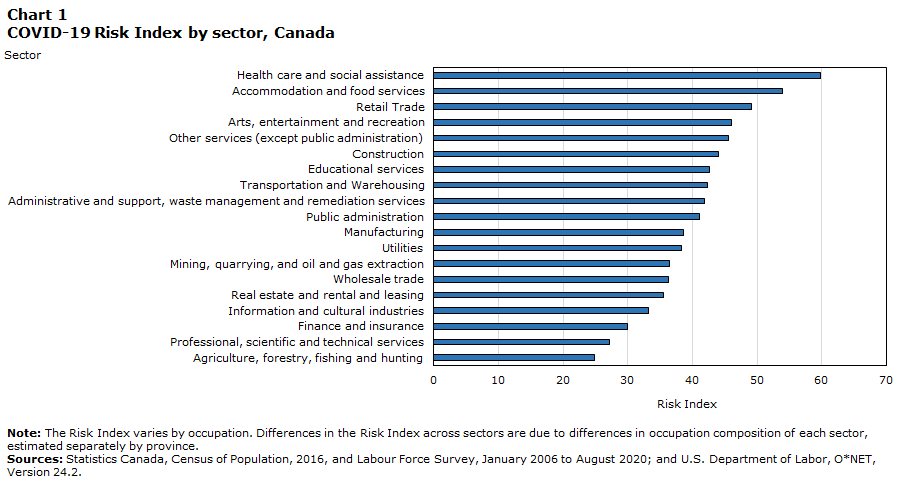Economic and Social Reports
An occupational risk/reward assessment tool for COVID-19
by Zhe Yang, Aneta Bonikowska and Marc Frenette
DOI: https://doi.org/10.25318/36280001202100400006-eng
Different sectors of the economy present different levels of risk of exposure to the coronavirus. Information about this risk may be important for evidence-based decision-making about how and when to impose or ease restrictions on businesses. To respond to this need, a network of academic researchers across Canada (Baylis et al. 2020) developed a new tool to measure the risk of COVID-19 exposure by occupation, and the importance of different sectors to the economy. The tool has been available to the public since spring 2020 through an app hosted by the University of British Columbia and Centre interuniversitaire de recherche en analyse des organisations (CIRANO). An updated version of the tool is now available at Statistics Canada through custom tabulations.
The COVID-19 Risk/Reward Assessment Tool consists of two parts. The first is the COVID-19 Risk Index that ranks occupations by the risk of exposure to the virus based on job characteristics (proximity or close contact with others, frequency of personal contacts, exposure to diseases or infections, interaction with the public, outdoor work, and the job can be done from home) and worker characteristics (commutes using public transit, works from home, lives in a crowded dwelling, and lives with a health care worker). For example, the risk of exposure to the virus is highest in the healthcare and social assistance sector, and lowest in the agriculture, forestry, fishing and hunting sector (Chart 1).

Data table for Chart 1
| Sector | Risk Index |
|---|---|
| Health care and social assistance | 59.9 |
| Accommodation and food services | 53.9 |
| Retail Trade | 49.1 |
| Arts, entertainment and recreation | 46.1 |
| Other services (except public administration) | 45.5 |
| Construction | 44.0 |
| Educational services | 42.6 |
| Transportation and Warehousing | 42.3 |
| Administrative and support, waste management and remediation services | 41.8 |
| Public administration | 41.0 |
| Manufacturing | 38.6 |
| Utilities | 38.2 |
| Mining, quarrying, and oil and gas extraction | 36.5 |
| Wholesale trade | 36.4 |
| Real estate and rental and leasing | 35.5 |
| Information and cultural industries | 33.3 |
| Finance and insurance | 30.0 |
| Professional, scientific and technical services | 27.2 |
| Agriculture, forestry, fishing and hunting | 24.9 |
|
Note: The Risk Index varies by occupation. Differences in the Risk Index across sectors are due to differences in occupation composition of each sector, estimated separately by province. Sources: Statistics Canada, Census of Population, 2016, and Labour Force Survey, January 2006 to August 2020; and U.S. Department of Labor, O*NET, Version 24.2. |
|
The second part of the tool is the economic importance of different sectors measured several ways, including the size of employment (pre-pandemic), change in employment, or sector centrality (how important a sector is to the functioning of all other sectors in the economy).
The risk and sector importance estimates are available by province and, in certain instances, smaller levels of geography.
The tool can be used to help policymakers determine which sectors, or occupation groups within sectors, to restrict or re-open as the pandemic evolves. In the future, it may also be used to inform potential pandemics following appropriate modifications. Importantly, the COVID-19 Risk Index focuses on work-related risks, and does not explicitly account for community transmission risks associated with, for example, social gatherings. Furthermore, the tool does not account for the use of personal protective equipment, adherence to physical distancing and other public health officials’ recommendations on the job, and how it might vary across occupations/sectors.
Authors
Zhe Yang, Aneta Bonikowska and Marc Frenette are with the Social Analysis and Modelling Division, Analytical Studies Branch, at Statistics Canada.
Further information
The COVID-19 Risk/Reward Assessment Tool is now available through custom tabulations at Statistics Canada. For more information, contact Aneta Bonikowska (aneta.bonikowska@canada.ca).
The original COVID-19 Risk/Reward Assessment Tool, which does not contain recent updates by Statistics Canada, is available (in English only) as an app at: https://baylislab.shinyapps.io/vse-risk-tool/.
The link to equivalent results for Quebec (available in French only) at: https://cirano.qc.ca/fr/shiny/connollm/tool.
Reference
Baylis, P., P.L. Beauregard, M. Connolly, N. Fortin, D.A. Green, P.G. Cubillos, S. Gyetvay, C. Haeck, T.L. Molnar, G. Simard-Duplain, H.E. Siu, M. teNyenhuis, C. Warman. 2020. The Distribution of COVID-19 Related Risks. NBER Working Paper Series, no. 27881. Cambridge, Massachusetts: National Bureau of Economic Research. https://doi.org/10.3386/w27881
- Date modified: